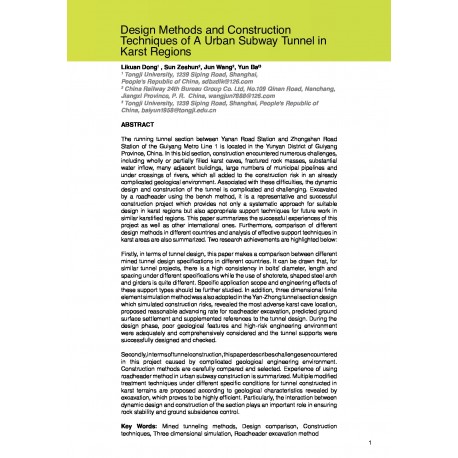Cart
0
0
No document
0,00 €
Total
Document successfully added to your shopping cart
Quantity
Total
There are 0 items in your cart.
There is 1 item in your cart.
Total documents
Total shipping
To be determined
Total
Search & filter
Search for a publication
Search & filter
Design Methods and Construction Techniques of A Urban Subway Tunnel in Karst Regions
3385_design_methods_and_construc
J. Wang / L. Dong / S. Zeshun / Y. Ba
The running tunnel section between Yanan Road Station and Zhongshan Road Station of the Guiyang Metro Line 1 is located in the Yunyan District of Guiyang Province, China. In this bid section, construction encountered numerous challenges, including wholly or partially filled karst caves, fractured rock masses, substantial water inflow, many adjacent buildings, large numbers of municipal pipelines and under crossings of rivers, which all added to the construction risk in an already complicated geological environment. Associated with these difficulties, the dynamic design and construction of the tunnel is complicated and challenging. Excavated by a roadheader using the bench method, it is a representative and successful construction project which provides not only a systematic approach for suitable design in karst regions but also appropriate support techniques for future work in similar karstified regions. This paper summarizes the successful experiences of this project as well as other international ones. Furthermore, comparison of different design methods in different countries and analysis of effective support techniques in karst areas are also summarized. Two research achievements are highlighted below:Firstly, in terms of tunnel design, this paper makes a comparison between different mined tunnel design specifications in different countries. It can be drawn that, for similar tunnel projects, there is a high consistency in bolts’ diameter, length and spacing under different specifications while the use of shotcrete, shaped steel arch and girders is quite different. Specific application scope and engineering effects of these support types should be further studied. In addition, three dimensional finite element simulation method was also adopted in the Yan-Zhong tunnel section design which simulated construction risks, revealed the most adverse karst cave location, proposed reasonable advancing rate for roadheader excavation, predicted ground surface settlement and supplemented references to the tunnel design. During the design phase, poor geological features and high-risk engineering environment were adequately and comprehensively considered and the tunnel supports were successfully designed and checked.Secondly, in terms of tunnel construction, this paper describes challenges encountered in this project caused by complicated geological engineering environment. Construction methods are carefully compared and selected. Experience of using roadheader method in urban subway construction is summarized. Multiple modified treatment techniques under different specific conditions for tunnel constructed in karst terrains are proposed according to geological characteristics revealed by excavation, which proves to be highly efficient.




